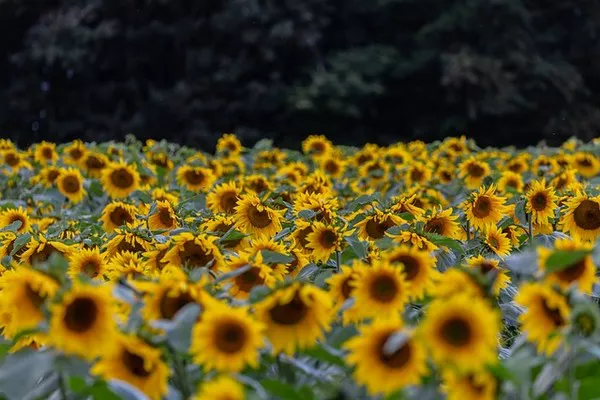Sunflowers, with their radiant golden blooms and towering heights, have captured the hearts of people worldwide. Whether adorning gardens, fields, or bouquets, these cheerful flowers symbolize happiness, warmth, and positivity. If you’ve ever wondered about the fascinating life cycle of sunflowers and how long they take to grow, you’re in the right place. In this comprehensive guide, we will explore the journey of sunflowers from seed to maturity, delving into the various growth stages and the factors influencing their development. So, let’s immerse ourselves in the world of sunflowers and uncover the secrets of their growth.
The Marvelous Journey Begins: Planting Sunflower Seeds
The life cycle of a sunflower begins with the planting of its seeds. Sunflower seeds are relatively easy to plant and can be sown directly into the ground or started indoors before transplanting. The best time to plant sunflower seeds is in the spring when the soil has warmed up and the threat of frost has passed. Select a sunny location with well-draining soil to provide the ideal growing conditions for these sun-loving flowers.
To plant sunflower seeds directly in the ground, create small holes about 1 to 2 inches deep and place one or two seeds in each hole. Cover the seeds with soil, water them gently, and watch as the magic of growth begins. Alternatively, you can start seeds indoors in peat pots or seed trays a few weeks before the last frost date. Once the seedlings are about 2 to 3 inches tall, they are ready for transplanting into the garden.
Germination and Early Growth Stage
After the seeds are planted, the germination process commences, marking the beginning of the sunflower’s life. Germination typically takes between 7 to 10 days, though it may vary depending on the environmental conditions and seed quality. During this phase, the seed absorbs water and swells, initiating the development of the root system.
As the sunflower seedling emerges from the soil, its tiny cotyledons or seed leaves unfold, providing the young plant with its first nourishment. The root system grows in search of water and nutrients, anchoring the sunflower to the ground and enabling it to absorb essential elements for growth.
The Rising Glory: Sunflower Vegetative Growth
The vegetative growth stage is a critical period in the sunflower’s life cycle, characterized by rapid development of leaves and stems. During this phase, the sunflower dedicates its energy to establishing a strong foundation for its future growth.
The sunflower’s stem elongates, and its leaves unfurl to capture sunlight. The plant’s phototropic nature leads it to orient its leaves and flower buds to face the sun, a phenomenon known as heliotropism. This behavior allows the sunflower to maximize its exposure to sunlight and optimize photosynthesis, the process by which it converts light energy into chemical energy.
Throughout the vegetative growth stage, it is crucial to provide the sunflower with adequate water and nutrients to support its vigorous growth. Regular watering and a balanced fertilizer application will contribute to healthier, more robust plants.
The Majestic Unfolding: Bud Formation and Flowering
As the sunflower reaches maturity, it prepares to unveil its iconic and awe-inspiring bloom. The formation of flower buds signifies the approaching grand finale of its life cycle. The timing of flowering varies depending on the sunflower variety and growing conditions, but it typically occurs within 70 to 90 days after planting.
Once the flower buds have formed, they undergo a fascinating process of blooming. As the sunflower bud begins to open, it reveals its densely packed disc florets in the center, surrounded by vibrant yellow ray florets that resemble petals. The disk florets in the center are where the seeds will eventually develop.
The sunflower’s blooming period is a spectacle to behold, attracting not only human admirers but also various pollinators, such as bees and butterflies, who play a crucial role in fertilization.
Setting Seeds and Maturation
After the sunflower’s striking bloom has captivated onlookers, the plant transitions into the final stages of its life cycle. The pollinated disk florets now undergo fertilization, resulting in the development of seeds. Each sunflower can produce hundreds of seeds, contributing to its reputation as a prolific seed bearer.
As the seeds mature, the once vibrant yellow petals of the sunflower begin to fade and fall off, making way for the development of a unique seed head. The seed head matures, and the seeds within it become plump and full of energy, ready to support the next generation of sunflowers.
The Cycle Comes to an End: Harvesting and Seed Collection
The completion of the sunflower’s life cycle culminates in the harvesting and collection of its seeds. As the seeds reach full maturity and the back of the sunflower head turns brown, it is time to harvest the seeds for various purposes.
To collect sunflower seeds for consumption, allow the seeds to dry on the plant until they are easy to remove. Use your hands or a tool to detach the seeds from the head. Rinse the seeds to remove any debris and then dry them thoroughly before storing them in an airtight container.
Conclusion:
The life cycle of a sunflower is a remarkable journey of growth, blooming, and seed production. From the moment the seeds are planted to the maturation of the sunflower head, each stage offers a unique display of beauty and vitality. Understanding the stages of a sunflower’s life cycle enables us to appreciate the resilience and wonder of these magnificent blooms.
Whether grown for their stunning appearance or harvested for their nutritious seeds, sunflowers continue to captivate our hearts and gardens worldwide. By providing the right conditions and care, we can enjoy the splendor of sunflowers and witness the magic of nature’s cycle unfold before our eyes.


